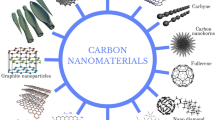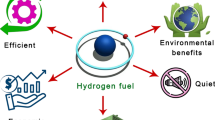Abstract
The hydrogen sorption capacity of carbon nanostructures was for several years a very controversial subject. Theoretical models have been published demonstrating a great potential for a large hydrogen sorption capacity of carbon nanostructures. Here we present a simple empirical model where condensation of hydrogen as a monolayer at the surface of nanotubes as well as bulk condensation in the cavity of the tube is assumed. The maximum potential amount of hydrogen absorbed according to the model was calculated to be 2.28×10-3 mass % S[m2g-1]=3.0 mass % for the adsorption of a monolayer hydrogen at the surface. The condensation of hydrogen in the cavity of the tube leads to a potential absorption for single wall nanotubes starting at 1.5 mass % and increasing with the diameter of the tubes. The experimentally measured hydrogen capacity of the nanotube samples correlates with the B.E.T. specific surface area. The slope of the linear relationship is 1.5×10-3 mass %/m2g-1. Therefore, the extrapolated maximum discharge capacity of a carbon sample is 2 mass %. Furthermore, it can be concluded, that the hydrogen sorption mechanism is related to the surface of the sample, i.e. a surface adsorption process.
Similar content being viewed by others
References
S. Iijima: Nature 354, 56 (1991)
N. Hamada, S. Sawada, A. Oshiyama: Phys. Rev. Lett. 68, 54 (1992)
M.S. Dresselhaus, G. Dresselhaus, P.C. Eklund: Science of Fullerenes and Carbon Nanotubes (Academic Press, NY 1996)
F. Darkrim, D. Levesque: J. Chem. Phys. 109, 4981 (1998)
S. Brunauer, P.H. Emmett, E. Teller: J. Amer. Chem. Soc. 60, 309 (1938)
F. London: Z. Physik. 63, 245 (1930); Z. Physik. Chem. 11, 222 (1930)
G. Stan, M.W. Cole: Low Temp. Phys. 100, 539 (1998)
Handbook of Chemistry and Physics, ed. by D.R. Linde, 76th. ed. (CRC Press, 1995–1996)
M. Rzepka, P. Lamp, M.A. de la Casa-Lillo: J. Phys. Chem. B102, 10849 (1998)
K.A. Williams, P.C. Eklund: Chem. Phys. Lett. 320, 352 (2000)
A.C. Switendick: Z. Phys. Chem. N.F. 117, 89 (1979)
R. Ströbel, L. Jörissen, T. Schliermann, V. Trapp, W. Schütz, K. Bohmhammel, G. Wolf, J. Garche: J. Power Sources 84, 221 (1999)
M.G. Nijkamp, J.E.M.J. Raaymakers, A.J. van Dillen, K.P. de Jong: Appl. Phys. A 72, 619 (2001)
C. Nützenadel, A. Züttel, L. Schlapbach: Electronic Properties of Novel Materials, Science and Technology of Molecular Nanostructures, ed. by H. Kuzmany, J. Fink, M. Mehring, S. Roth (Amer. Inst. Phys., NY 1999), p. 462
C. Nützenadel, A. Züttel, C. Emmenegger, P. Sudan, L. Schlapbach: Sciences and Applications of Nanotubes, Fundamental Materials Research Series, ed. by M.F. Thorpe (Kluwer Academic Publ./Plenum Press) p. 205
A. Züttel, P. Sudan, P. Mauron, C. Emmenegger, T. Kiyobayashi, L. Schlapbach: J. Metastable and Nanocrystalline Materials 11, 95 (2001)
S.M. Lee, K.S. Park, Y.C. Choi, Y.S. Park, J.M. Bok, D.J. Bae, K.S. Nahm, Y.G. Choi, S.C. Yu, N. Kim, T. Frauenheim, Y.H. Lee: Synthetic Metals 113, 209 (2000)
S.M. Lee, K.H. An, Y.H. Lee, G. Seifert, T. Frauenheim: J. Korean Phys. Soc. 38, 686 (2001); S.M. Lee, Y.H. Lee: Appl. Phys. Lett. 76, 2879 (2000)
J. Weitkamp, M. Fritz, S. Ernst: Int. J. Hydrogen Energy 20, 967 (1995)
H.W. Langmi, A. Walton, M.M. Al-Mamouri, S.R. Johnson, D. Book, J.D. Speight, P.P. Edwards, I. Gameson, P.A. Anderson, I.R. Harris: J. Alloys Compd. 356–357, 710–715 (2003)
S. Orimo, G. Majer, T. Fukunaga, A. Züttel, L. Schlapbach, H. Fujii: Appl. Phys. Lett. 75, 3093 (1999)
S. Orimo, T. Matsushima, H. Fujii, T. Fukunaga, G. Majer: J. Appl. Phys. 90, 1545 (2001)
A. Züttel, C. Nützenadel, P. Sudan, P. Mauron, C. Emmenegger, S. Rentsch, L. Schlapbach, A. Weidenkaff, T. Kiyobayashi: J. Alloys and Compounds 1, 676 (2002)
P. Ruffieux, O. Groning, M. Bielmann, P. Mauron, L. Schlapbach, P. Groning: Phys. Rev. B 66, 245416 (2002)
Author information
Authors and Affiliations
Corresponding author
Additional information
PACS
81.05.Uw; 81.07.De; 82.33.Pt
Rights and permissions
About this article
Cite this article
Züttel, A., Sudan, P., Mauron, P. et al. Model for the hydrogen adsorption on carbon nanostructures. Appl. Phys. A 78, 941–946 (2004). https://doi.org/10.1007/s00339-003-2412-1
Received:
Accepted:
Published:
Issue Date:
DOI: https://doi.org/10.1007/s00339-003-2412-1




